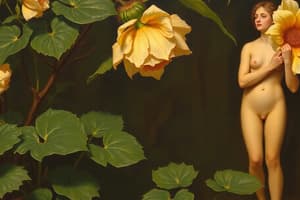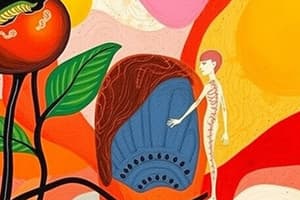Podcast
Questions and Answers
What part of an insect pollinated flower contains the male gametes?
What part of an insect pollinated flower contains the male gametes?
- Ovules
- Ovary
- Pollen grains (correct)
- Stigma
Which component of the insect pollinated flower is primarily responsible for producing the female gametes?
Which component of the insect pollinated flower is primarily responsible for producing the female gametes?
- Sepals
- Anthers
- Filaments
- Carpel (correct)
What is the correct sequence of gametes coming together during fertilization in plants?
What is the correct sequence of gametes coming together during fertilization in plants?
- Style and ovary
- Stigma and ovary
- Ovules and pollen grains
- Pollen grains and ovules (correct)
Which part of an insect pollinated flower is involved in the transfer of pollen to the stigma?
Which part of an insect pollinated flower is involved in the transfer of pollen to the stigma?
How do insect pollinated flowers primarily adapt to facilitate fertilization?
How do insect pollinated flowers primarily adapt to facilitate fertilization?
What is a characteristic feature of asexual reproduction?
What is a characteristic feature of asexual reproduction?
Which process exemplifies a method of asexual reproduction?
Which process exemplifies a method of asexual reproduction?
Which statement accurately describes the offspring produced through asexual reproduction?
Which statement accurately describes the offspring produced through asexual reproduction?
In which type of reproduction is the involvement of sexual organs least significant?
In which type of reproduction is the involvement of sexual organs least significant?
How does asexual reproduction primarily affect genetic diversity?
How does asexual reproduction primarily affect genetic diversity?
Flashcards are hidden until you start studying
Study Notes
Asexual Reproduction
- Involves only one parent, no sex cells or fertilization needed.
- Offspring are genetically identical clones of the parent.
- Defined as a process leading to identical offspring from a single parent.
Examples of Asexual Reproduction
- Bacteria undergo binary fission, producing exact genetic copies of themselves.
Sexual Reproduction in Plants
- Flowers serve as the reproductive organs, facilitating the merging of plant gametes.
- Male gametes are contained in pollen grains; female gametes are found in ovules.
- Pollination is the transfer of pollen from the male to the female parts of flowers, accomplished by insects or wind.
Structure of Insect Pollinated Flowers
- Main components include:
- Sepals
- Petals
- Stamens (male part), including filaments and anthers
- Carpel (female part), consisting of style, stigma, ovary, and ovules
- Structure is adapted to attract insects for effective pollen transfer.
Haploid and Diploid Cells
- Gametes (sperm and egg) are haploid, containing half the usual chromosome number (23 in humans).
- A zygote is diploid, containing 23 pairs (46 total chromosomes) as it develops into a fetus and embryo.
Advantages and Disadvantages of Sexual Reproduction
- Advantages: Increases genetic variation, enabling adaptation to environmental changes and higher crop yield.
- Disadvantages: Variation can also lead to less successful offspring that may struggle to grow or yield well compared to parent plants.
Studying That Suits You
Use AI to generate personalized quizzes and flashcards to suit your learning preferences.




